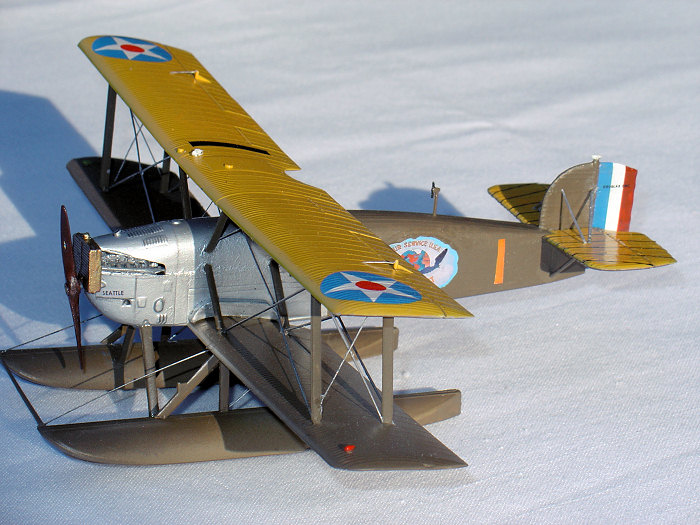
Williams Bros 1/72 Douglas World Cruiser
| KIT #: | 72-424 |
| PRICE: | around $15.00 MSRP when it was new |
| DECALS: | All four aircraft |
| REVIEWER: | Dan Hamilton |
| NOTES: | A delightful kit of an important and butt-ugly airplane |

| HISTORY |
One of the Holy Grails of aeronautics in the
1920’s was to be the first to fly around the world. In 1923, to show it could
compete in this epic race with Europe’s great airpowers, the tiny U.S. Army
Air Service contracted with the new Douglas Company to have Donald Douglas and
his designer John Northrop design an aircraft capable of such an endurance
test -- essentially the company’s ugly as sin Navy DT-2 torpedo bomber
modified to carry large fuel tanks rather than ordinance and to have pontoons
(for flights over the Pacific and Atlantic oceans) that were interchangeable
with conventional wheeled landing gear (for flights over Asia, Europe and
North America). Though tightwad President Calvin Coolidge thought the Army
needed only one plane that four crews could take turns flying, the Army‘s
studies determined a flight of four aircraft would have the greatest chance of
success. 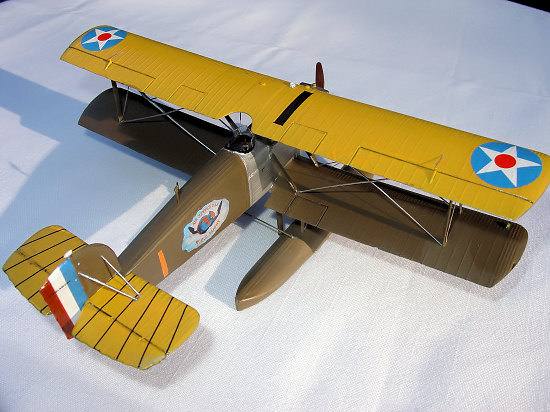 Each was named after a
major American city -- i.e. Seattle, Chicago, Boston and New Orleans. Because
Seattle would be the starting point, its namesake was designated as the
flight’s flagship. The leader of the cruise was to be the 42 year old Major
Frederick Martin --- handpicked by General William “Billy” Mitchell,
reportedly more for his diplomatic than flying skills because of the many
countries in which the flight would have to refuel and refit.
Each was named after a
major American city -- i.e. Seattle, Chicago, Boston and New Orleans. Because
Seattle would be the starting point, its namesake was designated as the
flight’s flagship. The leader of the cruise was to be the 42 year old Major
Frederick Martin --- handpicked by General William “Billy” Mitchell,
reportedly more for his diplomatic than flying skills because of the many
countries in which the flight would have to refuel and refit.
On April 6, 1924, America’s four entries onto the world stage of flight and their two man crews left Lake Washington’s Sandpoint Field on the first leg of what would be a path breaking and perilous six month adventure. They would turn out to be not just the first, but apparently even to this day the only, single engine open cockpit planes to complete a flight around the world -- all without loss of life or major injury. Even so, plane number 1 -- the “Seattle” -- still met with a violent end. Separated from the rest of the flight over Alaska, Major Martin eventually flew the “Seattle” into a fog draped mountain. Somehow, neither he nor his mechanic Sergeant Alva Harvey were seriously injured. Even more remarkably, with little more than a compass, canteen and canned meat, they somehow trekked for 10 days through knee deep snow just ahead of a snow storm before meeting a helpful Eskimo who took them to a cannery on Alaska’s Pacific coast to Moller Bay. Though plane number 3, the “Boston,” later sank during the flight’s homeward Atlantic crossing, its crew also was rescued and -- unlike Martin and Harvey -- were allowed a triumphal return to America in the prototype that was quickly rechristened the “Boston II” and flown to join the remaining two planes on their Nova Scotia to Boston leg. Major Martin would be relegated to welcoming back his replacement in command of the flight -- Lt. Lowell Smith -- and the other fliers when they arrived in Seattle to complete their trip on September 28, 1924. Years later Martin suffered an even greater ignominy: he was in the wrong place at the wrong time when as commander of the Hawaiian Air force at Hickam Field he was relieved after it was attacked on December 7, 1941. Though he had warned of a possible Japanese attack, Martin ended his career commanding the Second Air Force in Spokane Washington.
The surviving “Chicago” is now prominently displayed in the Smithsonian’s Air and Space Museum and the “New Orleans” is on long term loan to the Santa Monica Museum of Flying -- the city of its original construction. In contrast, what little remains of the “Seattle“ -- such as its broken wooden propeller and rusted Liberty Engine -- can be found at the Alaska Aviation Heritage Museum. However, the “Seattle” -- or its reasonable facsimile -- still may have another a chance to finish the flight and join its sisters in its own glorious museum display. In order to revive interest in this largely forgotten achievement in aviation history, a group in Renton Washington currently is fabricating their own Douglas World Cruiser -- the “Seattle II” -- which they hope to fly around the world and then donate as a memorial to the Seattle area Museum of Flight.
| THE KIT |
Nicely molded in gray plastic with little to no
flash, this 1970’s era kit contains no resin, no photo etch, no canopy masks
-- none of the “extras” we middle aged modelers with discretionary incomes
have come to expect Nevertheless, to my uninformed retro modeling eye this
long out of production kit holds up very well to modern standards. Indeed, a
very effective low tech feature is
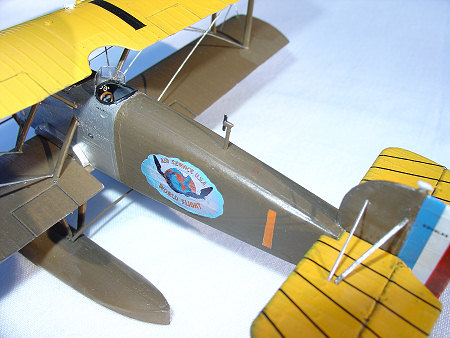 two thin clear plastic sheets
in the shape of flattened windscreens that when bent at the appropriate places
and angles make very convincing and appropriately thin three dimensional
windshields for the pilot and mechanic. The cockpits include seats, the
appropriate style control wheels and columns, passable decals for the
instruments and rudder bars molded into the floorboard. Small touches to the
exterior include such things as the protruding compass and fuel pump
“impellers” (apparently little propellers on sticks to generate power for
various devices).
two thin clear plastic sheets
in the shape of flattened windscreens that when bent at the appropriate places
and angles make very convincing and appropriately thin three dimensional
windshields for the pilot and mechanic. The cockpits include seats, the
appropriate style control wheels and columns, passable decals for the
instruments and rudder bars molded into the floorboard. Small touches to the
exterior include such things as the protruding compass and fuel pump
“impellers” (apparently little propellers on sticks to generate power for
various devices).
Of course the kit includes the classic Williams Brothers instructions -- a single poster sized two sided sheet with drawings on one side and fine print text on the other. Missing the modern step-by-step pictures-only directions containing supposedly universal symbols rather than English words, they are somewhat jarring to a 21st Century modeler of Japanese and Eastern European kits. However, in this archaic fine print is a wealth of helpful construction and finishing information that I’ve seldom found in other than Williams Brothers kits. On the down side, the box top claims it contains “decals to allow finishing model as any one of five different aircraft” -- even the “Boston II.” However, one will look in vain for the name “Seattle“ on the decal sheet. As if to add further disrespect to the ill fated “Seattle,“ the kit was obviously designed to depict the planes as they appeared at the time of the completion of their journey (and the way the surviving aircraft now appear in museums). Hence, the exhaust manifolds and markings provided are only as they appeared after they were modified en route. Any attempt to build the planes as they would have appeared at the start of their journey, or as the “Seattle“ which crashed before those modifications were made, requires some significant research but only minor scratch building. Here, the instruction fine print comes in handy, providing at least the necessary factual detail that is not provided in parts on the sprues or decals on the sheet.
| CONSTRUCTION |
Being a native and proud Seattleite, and hence
enamored with lost causes, my choice of which city’s plane to construct was
preordained. From a construction point of view, this meant the model would be
built with pontoons because the “Seattle” never made it to Asia for the switch
to wheeled landing gear. Also, the exhaust manifold had to be modified which
was easily done by 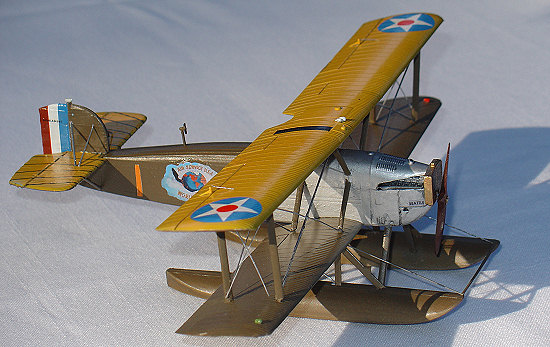 trimming the
stacks of the part that was provided and adding some stretched sprue to match
the drawing on the instructions and my reference photos. Otherwise, the kit
was constructed as per instructions.
trimming the
stacks of the part that was provided and adding some stretched sprue to match
the drawing on the instructions and my reference photos. Otherwise, the kit
was constructed as per instructions.
It should be noted that one of my biggest fears of bi-plane model construction -- the dreaded wing assembly -- was a relative breeze. This was so because the inboard wing struts are built into the fuselage and thereby provide the stability needed for linking the top and lower wings. My order of battle entailed finishing the fuselage, gluing the outboard struts onto the lower wing and after they dried, gluing the top and bottom wing to the inboard struts and when they in turn tried, finally warping the wings so as at glue the upper wing to the outboard struts. The only problem I experienced was that the design of the inboard struts into the fuselage required filling and sanding of gaps that were beyond what my modest modeling skills allowed. Hence, the wings assembled well but my inboard struts do not blend well into the fuselage. Filling and sanding always seem to be my tragic modeling flaw -- proving Aristotle‘s conclusion that every tragic hero has within him the seeds of his own destruction.
After completion, I used stretched sprue -- with varying degrees of success -- for the rigging. It was then finished off with a few coats of semi-gloss spray because the photos and museum pieces both show a nice finish existed. However, like its full scale namesake, my replica of the “Seattle” met a horrible fate -- I dropped it after bringing it out of the garage after applying its final coat and destroyed its floats, wing assembly and various rigging efforts. Once I had collected my emotions after allowing my head to spend some quality time testing the structural integrity of a wall, I remade some struts and other pieces and tried again. It is now as you see it in the photos -- but, oh, how wonderful it looked before the crash!
| COLORS & MARKINGS |
The instructions and other resources said the aircraft’s fabric surface was “Khaki” while the upper wing was “yellow” -- but what did that mean? My resources described the fabric color as “being a blend of chocolate-brown and olive green” and the color of the top of the upper wing and horizontal stabilizer as “chromate yellow.” Looking at photos of the surviving aircraft, it appeared that the “khaki” and “orange yellow” paint chips in The Official Monogram US Army Air Service & Air Corps Color Guide came closest. I then did my best to mix the paint to match.
 Though
nowhere mentioned in any of my resources, it was clear from examining photos
that the plane numbers on the side of the fuselage had been a different darker
color than the white decals provided with the kit. From examining photos of
the flight‘s progress, it appears the numbers were repainted white in Calcutta
when the floats were exchanged for wheels. Even a helpful archivist at the
Smithsonian (this is a wonderful service they provide by email!) was only able
to confirm that the color had indeed changed at some point but also could not
determine what that initial darker color (the only color the “Seattle” would
have had) originally was. Then the small print in the instructions came to the
rescue, informing me that “the fuselage side numbers, though originally
thought to have been orange, were repainted white.“
Though
nowhere mentioned in any of my resources, it was clear from examining photos
that the plane numbers on the side of the fuselage had been a different darker
color than the white decals provided with the kit. From examining photos of
the flight‘s progress, it appears the numbers were repainted white in Calcutta
when the floats were exchanged for wheels. Even a helpful archivist at the
Smithsonian (this is a wonderful service they provide by email!) was only able
to confirm that the color had indeed changed at some point but also could not
determine what that initial darker color (the only color the “Seattle” would
have had) originally was. Then the small print in the instructions came to the
rescue, informing me that “the fuselage side numbers, though originally
thought to have been orange, were repainted white.“
Accordingly, using Testor’s “Sure thing Decal Maker” software I made two appropriately sized orange number 1’s and two “Seattle” monikers that had been left off the decal sheet. Because I’ve never been able to make clear decal paper work well, I used white decal paper which is unfortunately apparent in the final results. However, I made a far more convincing decal of the “World Flight” logo -- the one provided in the kit was two colors on a white background and essentially illegible. This was done by finding a photograph of the real thing on the internet and then manipulating the image a little in Corel workshop. It was this emblem, in fact, that became basis for Douglas‘ later “First around the world” logo which was in turn incorporated by Boeing into its symbol when it took over McDonald Douglas.
| CONCLUSIONS |
My father, a Boeing employee during the 1950’s to 1970’s in Seattle, could never mention a McDonald Douglas plane without adding the prefix “damn“ to its name (e.g. at the boarding gate: “I’m not taking a damn McDonald Douglas DC-10 am I?”). Yes, this first of the great Douglas planes looked like a flying brick, but it could go the distance. Considering how the model appeared before it crashed (you‘ll have to take my word on this), the kit requires only average skill to do a quality job. It will make a beautiful model of a butt ugly -- but historically significant -- milestone in what came to be a century of American dominance in aeronautics.
| REFERENCES |
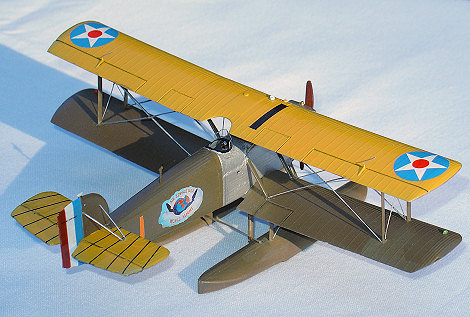 First
Flight Around the World: April 6-September 28, 1924,
Carroll V. Glines & Stan Cohen (2000)
First
Flight Around the World: April 6-September 28, 1924,
Carroll V. Glines & Stan Cohen (2000)
The Official Monogram US Army Air Service & Air Corps Color Guide, Vol. 1 (1908-1941), Robert Archer (1995)
“First Flight Around the World: The Epic Flight of the Douglas World Cruisers,” E.R. Johnson, Skyways Magazine (2004)
“The Great Air Race of 1924,” The American Experience, PBS documentary.
Smithsonian, Air and Space Museum (http://www.nasm.si.edu/research/aero/aircraft/douglas_dwc.htm)
Alaska Aviation Heritage Museum (http://home.gci.net/%7Eaahm/planes/seattle.html )
The Seattle World Cruiser Association (http://www.seattleworldcruiser.org/home.htm)
Santa Monica
If you would like your product reviewed fairly and fairly quickly, please contact the editor or see other details in the Note to Contributors.